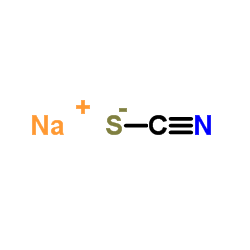Sodium thiocyanate

Sodium thiocyanate structure
|
Common Name | Sodium thiocyanate | ||
|---|---|---|---|---|
| CAS Number | 540-72-7 | Molecular Weight | 81.072 | |
| Density | 1.295 g/mL at 20 °C | Boiling Point | 146ºC at 760mmHg | |
| Molecular Formula | CNNaS | Melting Point | 287 °C (dec.)(lit.) | |
| MSDS | Chinese USA | Flash Point | 42.1ºC | |
| Symbol |

GHS07 |
Signal Word | Warning | |
|
Effect of co-ligands on chemical and biological properties of (99m)Tc(III) complexes [(99m)Tc(L)(CDO)(CDOH)2BMe] (L=Cl, F, SCN and N3; CDOH2=cyclohexanedione dioxime).
Nucl. Med. Biol. 41(10) , 813-24, (2014) (99m)Tc-Teboroxime ([(99m)TcCl(CDO)(CDOH)2BMe]) is a member of the BATO (boronic acid adducts of technetium dioximes) class of (99m)Tc(III) complexes. This study sought to explore the impact of co-ligands on solution stability, heart uptake and myocardial ret... |
|
|
Evaluation of an electrochemical method for the analysis of enzymatic inhibition reactions.
Anal. Sci. 29(1) , 25-9, (2013) An approximate equation for bioelectrocatalitic current was applied to an inhibition reaction analysis of bilirubin oxidase by anion (Cl(-), SCN(-), and F(-)) in order to assess the possibility of the electrochemical method for the analysis of enzymatic inhib... |
|
|
Supramolecular helix-to-helix induction: a 3D anionic framework containing double-helical strands templated by cationic triple-stranded cluster helicates.
Angew. Chem. Int. Ed. Engl. 47(9) , 1711-4, (2008)
|
|
|
Virus inactivation by protein denaturants used in affinity chromatography.
Biologicals 35(4) , 343-7, (2007) Virus inactivation by a number of protein denaturants commonly used in gel affinity chromatography for protein elution and gel recycling has been investigated. The enveloped viruses Sindbis, herpes simplex-1 and vaccinia, and the non-enveloped virus polio-1 w... |
|
|
Zinc sulfide nanoparticles selectively induce cytotoxic and genotoxic effects on leukemic cells: involvement of reactive oxygen species and tumor necrosis factor alpha.
J. Appl. Toxicol. 34(11) , 1130-44, (2014) The aim of the present study was to develop zinc sulfide nanoparticles (ZnS NPs) and to study their cytotoxicity against the KG-1A (human acute myeloid leukemia) cell line. ZnS NPs were synthesized using the pyrolytic method and characterized by X-ray diffrac... |
|
|
A comparative study for adsorption of lysozyme from aqueous samples onto Fe3O4 magnetic nanoparticles using different ionic liquids as modifier.
Amino Acids 47 , 2483-93, (2015) In this paper, nanoparticles of Fe3O4 as well as their modified forms with different ionic liquids (IL-Fe3O4) were prepared and used for adsorption of lysozyme. The mean size and the surface morphology of the nanoparticles were characterized by TEM, XRD and F... |
|
|
Oxidation of Monolignols by Members of the Berberine Bridge Enzyme Family Suggests a Role in Plant Cell Wall Metabolism.
J. Biol. Chem. 290 , 18770-81, (2015) Plant genomes contain a large number of genes encoding for berberine bridge enzyme (BBE)-like enzymes. Despite the widespread occurrence and abundance of this protein family in the plant kingdom, the biochemical function remains largely unexplored. In this st... |
|
|
Effect of salt additives on protein partition in polyethylene glycol-sodium sulfate aqueous two-phase systems.
Biochim. Biophys. Acta 1834(12) , 2859-66, (2013) Partitioning of 15 proteins in polyethylene glycol (PEG)-sodium sulfate aqueous two-phase systems (ATPS) formed by PEG of two different molecular weights, PEG-600 and PEG-8000 in the presence of different buffers at pH7.4 was studied. The effect of two salt a... |
|
|
Dextromethorphan mediated bitter taste receptor activation in the pulmonary circuit causes vasoconstriction.
PLoS ONE 9(10) , e110373, (2014) Activation of bitter taste receptors (T2Rs) in human airway smooth muscle cells leads to muscle relaxation and bronchodilation. This finding led to our hypothesis that T2Rs are expressed in human pulmonary artery smooth muscle cells and might be involved in r... |
|
|
Genetic features of oligodendrogliomas and presence of seizures. The relationship of seizures and genetics in LGOs.
Clin. Neuropathol. 33(4) , 292-8, (2014) Low grade oligodendrogliomas (LGO) are diffusely infiltrating World Health Organization (WHO) grade II gliomas, 20 - 30% of which show contrast enhancement. Seizures are a common presenting feature. It has been suggested that 1p19q co-deletion is associated w... |